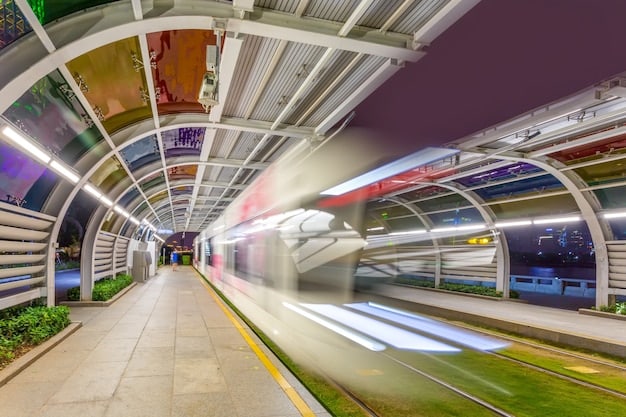US Transportation Policy: Impact on Infrastructure Projects Next Year

The latest US transportation policy is poised to significantly reshape infrastructure projects in the coming year by reallocating funds, prioritizing specific sectors like EV charging and public transit, and introducing new regulatory frameworks aimed at efficiency and climate resilience.
Understanding how the latest US transportation policy will impact infrastructure projects in the next year is crucial for stakeholders across various sectors. This evolving landscape promises both challenges and unprecedented opportunities for development and innovation, signaling a transformative period for American infrastructure.
understanding the new policy paradigm
The recent shift in US transportation policy introduces a new era for infrastructure development, moving beyond traditional road and bridge repair to embrace a more holistic and forward-looking approach. This paradigm is not merely about increasing spending but strategically directing funds towards projects that align with national priorities, including climate resilience, equitable access, and technological integration. The vision is to create a transportation system that is not only robust but also sustainable and inclusive, fostering economic growth while addressing environmental concerns.
Driving Factors Behind Policy Changes
Several critical factors have converged to necessitate these policy adjustments. Decades of underinvestment have led to a significant backlog of deteriorating infrastructure, directly impacting economic efficiency and public safety. Furthermore, the undeniable urgency of climate change demands a reimagining of transportation, with a strong emphasis on reducing carbon emissions and adapting to extreme weather events. Finally, the rapid pace of technological innovation, from electric vehicles to autonomous systems, requires a flexible policy framework that can facilitate, rather than hinder, progress.
- Aging infrastructure: A vast network of roads, bridges, and public transit systems requires urgent modernization.
- Climate change imperatives: Reducing carbon footprint and building resilience against environmental shifts.
- Technological advancements: Integrating new solutions like EV infrastructure and smart transportation systems.
The new policy aims to address these multifaceted challenges head-on, providing significant federal backing and incentives for states and local communities to embark on ambitious projects. It emphasizes performance-based metrics, encouraging innovative solutions and ensuring that investments yield tangible benefits for the public. This shift represents a commitment to long-term planning and sustainability, moving away from a piecemeal approach to a more integrated national strategy.
A central tenet of this new policy is the emphasis on collaboration. It encourages partnerships between federal, state, and local governments, as well as private sector entities, to maximize resources and expertise. This collaborative spirit is essential for tackling projects of significant scale and complexity, ensuring that diverse perspectives are incorporated into the planning and implementation phases. Ultimately, the success of this new policy paradigm will hinge on its ability to catalyze these partnerships and translate strategic visions into concrete results on the ground.
financial implications and funding streams
The sheer scale of the latest US transportation policy’s ambitions is mirrored by the substantial financial commitments it entails. This policy represents one of the largest infrastructure investments in generations, designed to inject billions of dollars into the economy over the coming years. Understanding the various funding streams and their allocation mechanisms is paramount for prospective project developers, government agencies, and communities aiming to leverage these opportunities.
Diverse Funding Sources Unveiled
The policy draws upon a diversified portfolio of funding sources, each with specific objectives and targeting mechanisms. A significant portion comes from existing federal trust funds, bolstered by new appropriations and innovative financing tools. This multi-pronged approach ensures a stable and predictable flow of capital for long-term projects. Furthermore, mechanisms like competitive grants and low-interest loans are designed to incentivize projects that align with the policy’s strategic goals, such as sustainability and equity.
- Dedicated federal allocations: Direct funds from the Treasury for critical national projects.
- Competitive grant programs: Encouraging innovative proposals from states and local entities.
- Public-private partnerships (PPPs): Leveraging private capital and expertise for large-scale developments.
Beyond traditional allocations, the policy also encourages states and municipalities to explore their own matching funds and innovative local financing options. This shared responsibility model aims to foster greater ownership and accountability at all levels of government. The availability of diverse funding options means that projects, from urban transit upgrades to rural broadband expansion, can find suitable financial backing, provided they meet the stipulated criteria and demonstrate clear public benefit.
One notable aspect of the financial strategy is the emphasis on transparency and accountability in fund dispersal. The policy outlines stringent reporting requirements and oversight mechanisms to ensure that taxpayer money is used efficiently and effectively. This focus on fiscal prudence is intended to build public trust and demonstrate the tangible returns on these significant investments. By clearly defining how funds are accessed and utilized, the policy seeks to maximize the impact of every dollar spent on infrastructure development.
key project areas and regional focus
While the new policy impacts the entirety of the US, it strategically prioritizes specific project areas and fosters a regional focus to address diverse needs and maximize impact. This targeted approach ensures that funding is allocated where it is most needed and where it can yield the greatest benefits in terms of economic growth, environmental sustainability, and social equity. Understanding these priority areas is crucial for stakeholders positioning themselves for future projects.
National Priorities and Geographic Distribution
At a national level, significant emphasis is placed on modernizing core infrastructure elements, expanding sustainable transportation options, and enhancing supply chain resilience. This includes, but is not limited to, substantial investments in public transit, passenger rail, electric vehicle charging infrastructure, and upgrades to ports and waterways. The geographic distribution of these projects will likely reflect current infrastructure deficiencies, population density, and strategic economic corridors, ensuring a broad national benefit.

For instance, urban centers are expected to see significant investments in public transportation upgrades, aiming to alleviate congestion and improve connectivity, while rural areas may benefit from improved road networks and enhanced digital infrastructure, bridging geographical divides. The policy also acknowledges the unique challenges faced by different regions, such as coastal communities grappling with rising sea levels or agricultural regions needing improved freight routes, allowing for tailored solutions.
Furthermore, the policy encourages regional planning and collaboration, recognizing that many infrastructure challenges transcend state lines. Multi-state initiatives that address shared transportation corridors, environmental concerns, or economic development zones are likely to receive preferential consideration. This holistic view aims to create integrated, resilient, and efficient transportation networks that serve the collective needs of broader geographic areas, rather than just individual jurisdictions.
The focus on specific project types also provides a clear roadmap for innovation and technological adoption. For example, the push for electric vehicle infrastructure goes beyond charging stations, encompassing grid modernization and smart city integration. Similarly, modernization of ports isn’t just about dredging; it involves automation, digital logistics, and improved intermodal connections. This strategic direction ensures that investments are not just about rebuilding the old but constructing the infrastructure of the future.
regulatory shifts and policy frameworks
Beyond financial incentives, the latest US transportation policy introduces a series of significant regulatory shifts and new policy frameworks designed to streamline project delivery, promote sustainable practices, and ensure greater accountability. These changes aim to create a more efficient and transparent environment for infrastructure development, reducing bureaucratic hurdles while upholding rigorous standards for environmental protection and worker safety.
Navigating the New Regulatory Landscape
One of the primary objectives of these regulatory adjustments is to accelerate the project approval process. This often involves measures to expedite environmental reviews, standardize permitting procedures across different agencies, and provide clearer guidelines for compliance. While maintaining high environmental standards, the goal is to prevent unnecessary delays that can inflate project costs and extend timelines. These streamlined processes are critical for translating policy ambitions into tangible infrastructure improvements quickly.
- Streamlined environmental reviews: Accelerating necessary assessments without compromising standards.
- Updated permitting processes: Reducing bureaucratic red tape for faster project commencement.
- Emphasis on Buy American provisions: Prioritizing domestically sourced materials and labor.
The new policy frameworks also place a strong emphasis on integrating climate resilience and equity considerations into all stages of project planning and implementation. This means that infrastructure projects must not only serve their primary transportation function but also demonstrate how they will withstand future climate impacts and provide equitable access and opportunities for all communities, including historically underserved populations. These are not merely suggestions but often mandatory requirements for receiving federal funding.
Furthermore, there is a renewed focus on performance-based metrics and data-driven decision-making. Agencies and project proponents are increasingly expected to demonstrate the measurable impact of their investments, using data to track progress and ensure that projects are meeting their intended outcomes. This increased accountability is designed to foster greater efficiency and ensure that public funds deliver maximum value. The regulatory environment is thus evolving to support both ambitious infrastructure goals and responsible resource management.
sustainability and resilience considerations
Central to the latest US transportation policy is an unequivocal commitment to sustainability and resilience, reflecting a nationwide recognition of climate change’s profound impact on infrastructure. This emphasis extends beyond simply reducing emissions to actively building a transportation system capable of withstanding future environmental challenges, adapting to changing conditions, and promoting a greener economy. These considerations are now deeply embedded in project selection and design.

Building for a Climate-Resilient Future
The policy outlines clear directives for incorporating climate resilience into all new and existing infrastructure projects. This includes measures such as designing bridges to withstand higher flood levels, reinforcing coastal roads against storm surges, and using permeable materials in urban areas to manage stormwater runoff. The goal is to minimize disruptions caused by extreme weather events and ensure the long-term operability of critical transportation networks. This proactive approach aims to save considerable costs in future repairs and avoid economic losses.
- Climate-proof design: Implementing engineering solutions for extreme weather events.
- Low-carbon transportation: Promoting electric vehicles, public transit, and active transportation.
- Ecosystem preservation: Minimizing environmental impact and enhancing natural habitats.
Beyond physical resilience, the policy also aggressively promotes sustainability through the widespread adoption of low-carbon transportation solutions. Significant investments are earmarked for public transit expansion, electric vehicle charging infrastructure, and the development of alternative fuels. These initiatives are designed to reduce the transportation sector’s carbon footprint, improve air quality in urban areas, and create green jobs within the emerging clean energy economy.
Another crucial aspect is the emphasis on integrated planning that considers the interdependence of transportation infrastructure with natural systems. This means designing projects that not only serve human mobility but also protect and enhance local ecosystems, critical habitats, and biodiversity. Projects that demonstrate a net positive environmental impact, through measures like restoring wetlands or using recycled materials, are likely to receive preferential treatment, reinforcing the policy’s comprehensive approach to sustainability.
economic impacts and job creation
The substantial investment within the latest US transportation policy is not merely about physical infrastructure; it is fundamentally about stimulating economic growth and creating jobs across a multitude of sectors. The policy is designed to generate both direct and indirect economic benefits, providing a significant boost to employment, fostering innovation, and increasing national competitiveness. This economic impetus is a core pillar of the policy’s strategic objectives.
Fostering Growth and Employment Across Sectors
Direct job creation will be seen immediately in the construction industry, with a surge in demand for engineers, skilled tradespeople, and general laborers. These jobs will be concentrated in diverse projects, from large-scale bridge replacements to the installation of electric vehicle charging stations. Beyond construction, significant ripple effects are anticipated in manufacturing (for materials and equipment), logistics, and various support services that cater to infrastructure development.
- Direct construction jobs: Engineers, laborers, and skilled trades.
- Manufacturing sector boost: Demand for steel, concrete, and advanced materials.
- Long-term operational roles: Maintenance, public transit operations, and EV infrastructure management.
The long-term economic impacts extend beyond the immediate construction phase. Improved transportation networks reduce commute times, lower logistics costs for businesses, and enhance access to markets, all of which contribute to increased productivity and economic efficiency. The expansion of public transit also provides equitable access to jobs and services, particularly for underserved communities, fostering more inclusive economic growth. These enhanced efficiencies translate into broader economic benefits for years to come.
Furthermore, the policy’s emphasis on green infrastructure and advanced technologies is expected to spur innovation and create new industries. Investments in electric vehicle infrastructure, smart city technologies, and sustainable materials will drive research and development, leading to the creation of high-skilled jobs in emerging fields. This forward-looking approach positions the US economy for future competitiveness, leveraging infrastructure investment as a catalyst for technological advancement and sustainable development.
| Key Aspect | Brief Description |
|---|---|
| 💰 Funding Surge | Billions dedicated to modernizing infrastructure, diverse funding streams. |
| 🛣️ Key Project Areas | Focus on public transit, EV infrastructure, roads, bridges, and ports. |
| 🌿 Sustainability Drive | Mandatory climate resilience & low-carbon solutions integration. |
| 🛠️ Job Creation | Expected boom in construction, manufacturing, and tech sectors. |
Frequently Asked Questions About Transportation Policy
The primary goal is to significantly upgrade and modernize the nation’s infrastructure, moving beyond traditional repairs to foster a more sustainable, equitable, and technologically advanced transportation system. It aims to boost economic growth, create jobs, and enhance resilience against climate change impacts, ensuring long-term national competitiveness and safety.
Funding will come from a combination of existing federal trust funds, new congressional appropriations, competitive grant programs, and the encouragement of public-private partnerships. States and local entities are also incentivized to contribute matching funds, creating a diversified and robust financial framework for large-scale investments.
The policy prioritizes a broad range of projects, including public transit expansion, advanced passenger rail, electric vehicle charging infrastructure rollout, upgrades to roads and bridges, and modernization of ports and waterways. Projects that incorporate climate resilience and equitable access are given significant preference in funding allocation.
The policy is expected to create millions of jobs directly in construction and indirectly in manufacturing, logistics, and emerging technology sectors. Improved infrastructure will enhance productivity, reduce transportation costs for businesses, and unlock new economic opportunities, contributing to sustained national growth and competitiveness.
Sustainability is a core component. The policy mandates integrating climate resilience into project designs to withstand future environmental changes and significantly promotes low-carbon transportation solutions. This includes investments in electric vehicles, public transit, and green building materials, aiming to reduce the sector’s carbon footprint and foster a more environmentally friendly infrastructure.
conclusion
The latest US transportation policy marks a pivotal moment for American infrastructure, moving far beyond mere repair to envision and fund a resilient, sustainable, and economically vibrant future. Its comprehensive approach, intertwining significant financial investment with clear regulatory frameworks and a strong emphasis on sustainability, is set to transform the nation’s physical landscape and economic outlook in the coming year and beyond. This ambitious undertaking demands collaboration and innovative solutions, promising a new era of progress that impacts every corner of the country.





